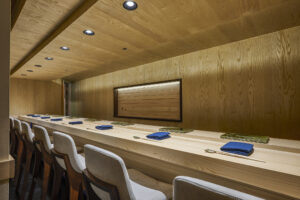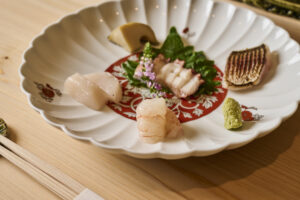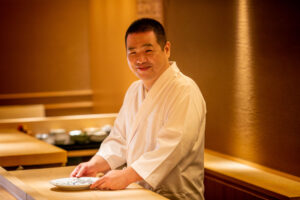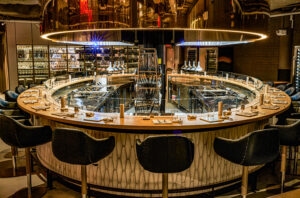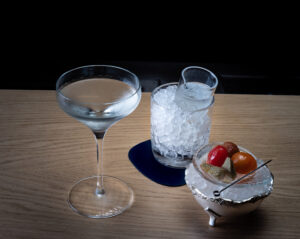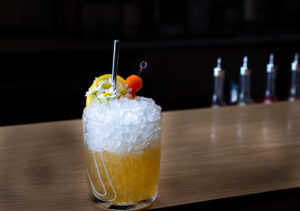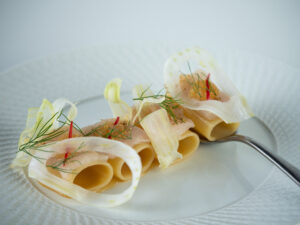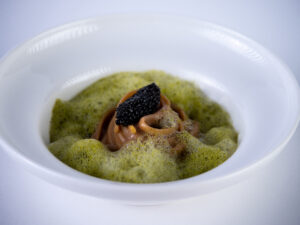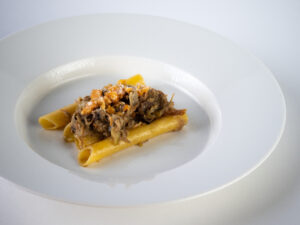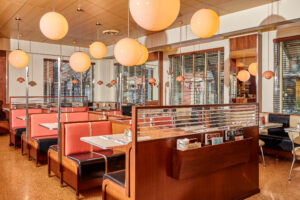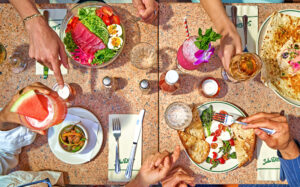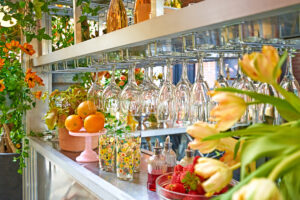From the creators of the famous snail mucin repair products, cult-favorite Korean skincare brand MIZON debuted their first ever retinol line. MIZON is known for their skin barrier repairing, hydrating products, so hearing about a retinol line from them was incredibly exciting. Retinol (Vitamin A) is known as a “magic” skincare ingredient, fighting acne and signs of aging through increasing skin cell production.
Megan D'Souza
Cortina Health brings an exciting teledermatology subscription model to the world of skincare!

Danny Chin | Omega Photo Studios
Designer Malan Breton makes his Autumn-Winter 23/24 NYFW splash with the evocative collection, Fantôme. Set inside the Lemán Ballroom in Tribeca, fashion-forward guests gathered from all corners or the city, and the broader world, to witness this ethereal show unfold.
On a wintery January day, we settled into a booth at a retro dining staple downtown, Soho Diner. I’d been once before for lunch, but had been dying to try out their brunch menu ever since.
Earlier this year, we got to check out Plan Do See’s famous Bubusan and Azabu New York. On Saturday, we went back to Azabu for their premier dining experience. The bottom level of the restaurant boasts a world-class Omakase experience: The Den. Nestled into a quiet street in Hudson Square, the New York location of Azabu Sushi draws inspiration from its wildly successful Miami counterpart while bringing in elements of New York charm.
It boasts a new name, new menu, and new space: Azabu New York aims to transport guests to Tokyo’s Azabu neighborhood, known today for its laid-back, chic vibe but originally as a hub for merchants and traders.
The interior of Azabu New York’s space is inspired by Buddhist and Shinto aesthetic qualities, with calming, simple decor, a hidden sliding-door entrance, and Noguchi lamps. Architect Ian Bentley of NOISE was the creative mind behind the new design. The Den emulates Buddhist design and Azabu captures Shinto elements, with its soft blonde wood counters and touches of cobalt blue.
We stopped by their happy hour launch a few months ago to sample some cocktails and excellently crafted nigiri, and learn more about the revamped Azabu’s mission. Sake, white wine, and red wine were served in beautifully designed cups as guests attending the launch settled into the clean, cozy space. We loved that happy hour, and were highly anticipating the opening of The Den, their second concept location of the Michelin-starred omakase speakeasy inside Azabu Miami Beach.
Our meal at The Den was an expertly crafted experience, led by Chef Toshihide Terado, who has over 20 years of culinary experience across the globe. The meal consisted of a series of appetizers, a toro tasting, chef’s choice seasonal nigiri, and finished off with miso soup and dessert. We started off with a carafe of Suijin Junmai sake, which was served in ornamental aluminum cups designed to conduct and maintain the temperature of the drink. It was the refreshing palate cleanser I craved and kept reaching for throughout the meal.
The few courses were a delish spread of crab salad, a mackerel preparation, squid and mantis shrimp. Each was bursting with flavor, both sweet and savory, and watching the careful creation of each dish took eating it to the next level. The nigiri portion of the Omakase began with a toro tasting: Akami (lean tuna), Chu-toro (medium fatty tuna), O-toro (fatty tuna) came out prepared with real wasabi, soy sauce, and sudachi (japanese lime). We had about 4 more pieces of nigiri which all blew me away, but my favorite was the Sanma which is also a type of mackerel. We wrapped up the meal with my favorite course of the night: uni rice topped with salmon roe and more firm uni. Decadent, creamy, and briny, this dish combined two of my favorite seafood items into one delicious flavor profile carried by the rice. After those amazing courses, we had some light and fluffy japanese omlette, comforting miso soup, and finished off the meal with the most juicy melon I’ve ever had.
Eating at The Den is an experience that treats all the senses, and it’s clear to see why the original Miami location earned a Michelin star. I loved all the dishes and the Chef’s explanations, and can’t wait to try more of Azabu New York’s offerings.
A new line of K-Beauty products is always a reason to get excited! MIZON just released their Phyto Plump series, which helps encourage youthful, hydrated skin using collagen. The line is vegan, and heals skin irritation and decreased elasticity using “Tremellan-MC Extract (known for suppressing free radicals, increasing the synthesis of collagen and moisturizing deep within the skin), Brown Algae Complex (known for retaining moisture, being high in proteins and suppressing inflammation) and D-panthenol (a provitamin of D-pantothenic acid that provides deep and long lasting moisturization, heals irritation and abrasions and improves luster and shine).”
I tried out five products in the range, the Toner, Serum, Day Cream, Night Cream, and Eye Gel patches, over the last month to see how they reacted to my skin.
First, I applied the Phyto Plump Collagen Toner right after cleansing my skin. While it was still a bit damp after drying, I poured a few drops of the toner into my hands and patted it into the skin. This toner feels almost like an essence, with a slightly thicker than water consistency. It feels luxurious and locks in the moisture, definitely leaving my skin looking plumped up and hydrated. Since I have normal skin and it’s not quite the dry winter season yet where I live, this toner was all I needed to quench my skin in the morning before I put on my sunscreen and makeup to head out the door.
Sometimes, when I wanted more dewy plumpness, I reached for the Phyto Plum Collagen Serum. It’s designed to “provide a dewy finish without the stickiness” and is lightweight enough to use during the daytime – it sinks right into your skin and feels like a more concentrated, thicker version of the toner. I noticed that my skin stayed hydrated and dewy all day when I used this product, and provided the perfect base for more “harsh” skincare treatments like retinol in the evening.

The final product in their Phyto Plump line is the Phyto Plump Gel Eye Patches. This was a new product for me in the rotation, since I’ve only used the single packets before for special occasions. The cooling slice of silicone sits comfortable under your eyes whether you sit back and relax or go about your other tasks, which is incredibly convenient for those on the go. I loved using these before heading out for the evening to meet friends for dinner or to an event. They leave your under eyes brightened, refreshed, and of course: plump. The patches left a nice layer of product even after I took them off, which left the perfect canvas for blending concealer seamlessly for a night out. I found these patches so fun to use, since they were outside my daily routine before I tried these products, and I might have to add them back in!
MIZON’s new Phyto Plump line is available on Amazon as of November 1st, and they also have lightning Black Friday deals:
- MIZON Snail Repair Intensive Gold Eye Gel Patch will be 37% off and MIZON All in One Snail Repair Cream (75ml) will be 25% off on November 25th from 8:35 AM PST to 8:35 PM PST
- Prime Exclusive Discount – MIZON Goodbye Blemish Soothing Gel Cream, Goodbye Blemish Fresh Toner, Goodbye Blemish Pink Spot, Cicaluronic Moisturizer, Collagen Miniature Set and Niacinamide Smoothing Body Lotion will be 20-35% off November 24th through November 28th, for prime members only.
Did you know you can experience Imperial Chinese Cuisine right here in New York? Chef Guo, an immersive space nestled in a corner of Midtown east, transports you to another world by activating all of your senses. Although the food draws customers in, the ambiance, carefully explained cultural insights, and attention to detail all come together harmoniously to create the perfect in-depth culinary experience.
I arrived early for my dinner at Chef Guo, and my server Caroline taught me about an ancient Chinese instrument they have displayed that was only played by the nobility. The instrument showcased in the restaurant was specially made as a high honor for Chef Guo by the Chinese government, and getting to try playing it felt like a privilege. 5 stone statues line the restaurant’s exit pathway, each representing a different season and different direction: Spring, Summer, Fall, and Winter, and North, South, East, and West. The fifth and most beloved statue is the baby dragon, which represents abundance. Guests are encouraged to rub its head before they depart post-meal to be blessed with wealth and prosperity.

The first course was a silver needle tea, meant to stimulate the appetite. Its warmth and aromatics definitely readied my palate as the next three appetizers arrived: a selection of cold hors d’oeuvres and a dish called The Butterfly Falling in Love with the Flower. The hors d’oeuvres captured the four major flavor profiles: sour beans, sweet radish, bitter gourd, and spicy anchovies. Combining these flavors resulted in the most delightful taste sensation. The Butterfly dish was a work of art: seafood, vegetables, and chinese sausage were carefully arranged to resemble a nature scene of florals and butterflies. The final appetizer was slow-cooked tofu in scallion sauce topped with caviar – so fresh and satisfying on the palate. I was amazed by the depth of flavor in the scallion puree.
Starting off with Magic Elixir and the Fruit of Longevity made of peach jelly, the next set of courses continued to wow me. The elixir was a peach jelly to invigorate the blood, and served in a delicate eggshell. The Big Red Robe Tea came out next, and Caroline explained its rich historical legacy to me: this tea was integral to US-China relations, and was served to President Nixon by Chairman Mao Zedong in the 1970s. It’s “worth more than gold” and is used as a palate cleanser throughout the meal, meant to be taken as a single sip between courses. The next course was Taiji Black Truffle, a soup presented as a Yin Yang symbol. The orange soup was chicken based, and the green soup was beef based, and each side was topped with a circle of shaved black truffle. This dish represents the Chef’s desire to modernize his cuisine – truffles are typically not an ingredient in Chinese cuisine, but his use of it enhanced the dish tremendously. Pan Fried Foie Gras Au Jus arrived next, which was crisped on the outside and served with blueberry sauce and veggies. The combo of this decadent dish served with fresh flavors kept it light, yet indulgent. Next, the Chef served Mustard Green, Black Rice, and Premium Lobster Tail, Contrasting local cold-water lobster, this lobster tail comes from warm oceans and therefore had a sweeter flavor and firmer texture. The final item of this group of courses was the Hundred Happinesses and Eight Treasures in a Pouch Bag. Each of the 8 ingredients are hand-picked by the Chef and unique to each person, so only you and the Chef know what’s in your pouch. It’s served in a wooden box inscribed with the Chinese character “Fu” which means happiness – the theme of the restaurant.
The next course, Sea Bass with Fried Noodle, was served in a traditional sweet and sour sauce. The traditional Chinese dish uses baked carp, so the sea bass brings a modern and global twist on this dish: which is tremendously satisfying due to the delectable sauce. Next was a menu item I’d been anticipating, the Authentic and Traditional Wagyu Beef. It’s the finest A5 available from Japan, seasoned only with salt, and served with a side of apple fries. As someone that doesn’t usually get excited for steak, this blew me away. Every bite was perfectly crispy on the outside yet juicy and tender inside, and the flavors of the fat and salt melted in my mouth. Following up this perfect dish was the Flame Smoked Duck Breast, served with friend onions and almond slivers as pine incense smoke tendrils wafted up from beneath the cut of meat. The Braised Morels with Double Mushrooms is a delicacy, served to represent the guests’ honorable status. Some of the Chef’s star dishes came next: the ChefGuo Signature Pork Chops and the ChefGuo Signature Noodles With Black Bean Sauce. The pork chops won an award against French chefs in an international competition, flavored with chinese pickles in lieu of salt and served with a homemade pocky stick.
The end of the meal concluded with a selection of light desserts. The Tricolor Sea Swallow is a diced fish bone found only under extreme ocean depths, served with 3 flavors: papaya puree, kiwi puree, and greek yogurt. The fibrous, crunchy fish carried each of the flavors so well, and was a delicious and creative dessert I thoroughly enjoyed. Finally, the Golden Orange Sits on a Swing, a peeled orange served beautifully, which is a classic Chinese dessert item meant to rid your mouth of any odors and send you refreshed from your meal back into the world. After that, we had a Post-Meal Tea, which was a delicious Pu’er with a complex and invigorating flavor.
My 19-course meal at Chef Guo was a transformative, educational experience and truly one of the best meals I’ve had in my life. If anyone wants to learn about Chinese culture, both traditional and modern, make your reservation at Chef Guo immediately!
A few weeks ago, we tried the new Italian restaurant in Chelsea Market. A less rushed alternative to the market’s typical grab-and-go options, La Devozione offers fine dining, casual dining, a market of artisanal goods, and also takeout. If the restaurant’s name sounds familiar, it’s because they stem from a well known pasta manufacturer with roots dating back more than 110 years – Pastificio di Martino. Their story is fascinating, with the aforementioned origins to the first takeaway stand in Naples, to now expanding into restaurants in the United States. Our last visit involved dining at A Tavola, their casual dining area, and we couldn’t wait to try The Oval for an immersive tasting experience with Chef Alessio Rosetti.
Well, today was that day! We entered Chelsea Market and wandered over to the restaurant, nestled in the very center across from the open-concept food court. Soon, we were seated at the impressive chef’s counter: an oblong round tabletop surrounding state-of-the-art stovetops, ovens, pasta stations, and more, also known as The Oval.
We began our meal with a few cocktails: the American Rose and the Select Aperitivo. Both drinks had a citrusy, bitter flavor profile with the former boasting a bit of fizz and the latter holding a more floral component from the juniper berries. They paired perfectly with our first course, which was a wafer made of over-boiled and mashed up pasta, then spread thin, seasoned with classic italian herbs, and dried out. It also came with two breadsticks, and delicious ‘cookies’ made with pork fat and crushed almonds. So unique, with familiar tastes but brand new formats, made for the perfect carb-based appetizer.
The second course was our first pasta, the Spaghettini a Limone. Bright and acidic yet balanced due to the creamy provolone sauce, it excited us about the rest of the courses to come. Lemon pasta is one of my absolute favorite dishes, so I could have happily eaten an entire meal of this alone. Next, the Pacchero Calabria arrived. A plate of 4 large paccheri, each topped with bergamot glaze, smoked swordfish, and fennel fronds, were like little flavor explosions. Citrusy and fresh, earthy, and smoky essences filled your mouth for a true gastronomical experience. I loved this small, punchy dish!
Next, the Sogno Rosso was a spaghetti with caviar and parlsey foam that came out for our fourth course. It was plated gorgeously with voluminous bright green parsley foam that keeps its shape for longer than expected. The flavors, once swirled together, were earthy and complex. The Marco Polo, a roasted beet goat cheese pasta, arrived next: a bright magenta colored sauce served in a large wine glass. Goat cheese comprised the main flavor, which quickly melted and incorporated into the pink sauce. This brightened the dish and added a whipped, creamy texture.
Our next course was a pick-your-own adventure: either the Candele Rotto a Mare or the Candele BBQ. Of course, we each chose one so we could sample both dishes. The Candele Rotto a Mare was a cripsy medley of octopus, squid, cuttlefish, and asparagus covered in a ragu sauce. The result? A seafood-heavy flavor balanced by the classic, neutral comfort of a red sauce that blended perfectly. The Candele BBQ was one of our favorite items of the night, with sizzling pork belly and creamy artichoke.
The final food course was the restaurant’s namesake dish – La Devozione. A simple tomato basil sauce yet so complex and satisfying in flavor, this pasta absolutely cannot disappoint – and that’s due to the quality of its ingredients. Tomatoes are from Sorrento which are harvested in the summer and canned to send to the US in the fall. In contrast to San Marzano tomatoes, these are richer and sweeter, giving the sauce an extraordinary flavor. This was our favorite item last time as it’s also on A Tavola’s menu, and was definitely near the top this time as well.
For dessert, we had a lime tart, which was a unique twist on the indulgent lemon tart. We finished off our meal with smooth, creamy espresso brewed in the moka pots La Devozione sells in their market. They were a delicious end to a decadent, artful meal. We highly recommend The Oval to anyone looking for an experience far greater than just a meal – a creative, interactive Chef-led lesson in Italian cuisine.
Spring Studios’ Mindfulness in Fashion talk, hosted by Alo, featured panelists Bianca Quiñes AKA Quin, Christa Janine, Kirat Randhawa, and Hilary Rhoda discuss mental health in their fields and how it plays into the fashion industry at large. Moderator Chrissy Rutherford asked meaningful questions to discover real experiences, learned habits, and more from each of the panelists. Christa and Kirat shared how growing up in religious homes focused on mental health as something that could be solved by prayer, and how they had to learn that “what it means to be well [for them] is different from what [they] were taught it meant to be well” (Randhawa). Panelists stressed the abundance mindset over the scarcity mindset, and then went into work life balance. Quin advised to “tell yourself [self-care/mindfulness] is non-negotiable, like brushing your teeth” in order to make it a priority. In order to show up for others and in the workplace, you must first show up for yourself and make sure that you’re able to care for yourself. Mindfulness is a “necessary means to be of service to the world” (Randhawa). We’ve all experienced the culture of busy-ness: those who seem frazzled by all they have going on, are perceived to be working harder – but we need to reframe the narrative to recognize that those who are calm and grounded aren’t necessarily not pushing themselves professionally. Overall, the fashion industry and other professional industries are slowly coming around to honor individuals’ mindfulness journeys, there’s still a long way to go. People are rapidly transforming their own self-care routines, and employers are going to have to catch up.
The next talk we attended focused on “quality, eco-conscious design that lasts a lifetime” from fashion to home design. Presented by LoveSac and moderated by Kerry Pieri, panelists Shawn Nelson, Abrima Erwiah, Olivia Ponton, Laura Hodges discussed The Long-term Luxury of Sustainability. Climate consequences affect everybody, and if they don’t feel real, it’s due to privilege and they’re guaranteed to catch up fast. LoveSac (who recently debuted a collection with Alice & Olivia) recycled 350 plastic bottles per couch, and is trying to lead the charge to make good design synonymous with sustainability. Currently, a misconception exists within the industry: you have to compromise on quality design to get sustainable products (think: bottlecap wall art, stiff plasticky rug) – but this is false. Additionally, the most sustainable item is the one you already have. Furniture design cycles used to be every 30 years and every 10 for fashion, but social media has been speeding up the process, and companies are racing to produce more output to satisfy this demand. Ultimately, all the panelists agreed that the biggest companies have the biggest input, so they need to get on board to make a significant difference.
The final talk I attended, Ten Years of Costuming the New York City Ballet Fall Fashion Gala, featured panelists Gianna Reisen, Marc Happel, Humberto Leon, Zac Posen talking about their experiences costuming the NYC Ballet. Donya Archer Bommer moderated a conversation designed for dance, in advance of the iconic Fashion Gala. The Ballet’s Gala features historic costumes over 50 years old that are still in use, as well as new design collaborations. The Ballet has collaborated with over 30 designers, first starting with Valentino back in 2012, under the direction of Vice Chair Sarah Jessica Parker. This Gala is the only time that costumes come first at the New York City Ballet – usually, designers need to prioritize lightness and movement to complement dancers’ movements. It’s also an opportunity for designers to try something outside their comfort zones and outside the usual world of fashion. Humberto Leon spoke about his experience bringing social commentary into his designs for the ballet – he looked at the dancers’ social media to learn about each dancers’ individual style, based their costumes off that, and put them in sneakers. This collection for 2016, meant to be a political protest, is still going around the fashion and dance world 6 years later. He also brought the collaboration back into the fashion world by having dancers be models in his fashion shows. They would “fall”, eliciting horrified gasps from the audience, and rise in a graceful way that showed the entire effect was intentional. In this way, both designers Zac Posen and Humberto Leon illustrated how they needed to reflect the dancer’s essence and the heart of the piece itself in their costumes. The fashion collaborations by the Ballet are a beautiful example of collaboration between two beloved NYC industries.
Amidst the buzz of fashion week in Soho this weekend, we grabbed a break and a bite to eat at Soho Diner. Perfectly situated under the Soho Grand hotel, a few minutes walk from fashion week hub Spring Studios, the Soho Diner was a great spot to unwind from the day’s activities and inspirations. We weren’t the only ones who thought so, clearly, as the 50s themed diner was packed with models, editors, and fashion fanatics.
When you walk into Soho Diner, you feel like you’ve instantly stepped back in time. Wait – scratch that a little – into a beautifully curated version of the past: salmon colored upholstered booths, cherry wood finishes, a Crosley jukebox, and vintage signs indicating menu items. Soho Diner “pays homage to the great American dining staple: a place where every stripe of the community can have a quality meal with friends and family.” But their modern touches remind you that you’re in a place with the charm of the past but the welcoming attitudes of modern day, rather than a perfect carbon copy of an imperfect past world.
Just like their ambiance, Soho Diner’s menu reflects the beauty of modern American cuisine and the classic comforts of staple diner items. From their classic burger and milkshake to a half dozen oyster starter and a grapefruit brulee, every type of eater will find their fix here. Since we went for brunch, we ordered the Smoked Salmon and Potato Latkes, the Steak and Eggs, and started off with a few oysters. And of course, some milkshakes – how could we not at a diner?!
To start off, our milkshakes came out first – an orange julius and a vanilla classic shake. The orange julius was creamy and citrusy, but still very light and refreshing even with its sweet flavor profile. To round it out, the vanilla milkshake was thick, decadent, and delicious. An absolute must try – they were out of the strawberry and chocolate flavors when we visited, so we can’t wait to stop by next time to try those.
After we finished our drinks, the oyster starter arrived. The east coast oysters were fresh and delicious – a must have during the summer season. They were served with the classic mignonette, spicy cucumber relish, harissa cocktail sauce, and a lemon wedge. All the accoutrements you could possibly want to accompany a set of oysters. Next up, our main dishes: the Potato Latkes with Smoked Salmon, and the Ham Steak and Eggs. The latkes came with herbed creme fraiche and poached eggs; their creaminess paired wonderfully with the salty smoked salmon. The steak and eggs arrived with specklings of chimichurri on a giant cut of pork, and topped with two sunny side up eggs – definitely plan on leftovers!
We left the Soho Diner full and happy, and can’t wait to go back to try the rest of the items on their menu. Learn more about Soho Diner here, and click here to make your reservation!





